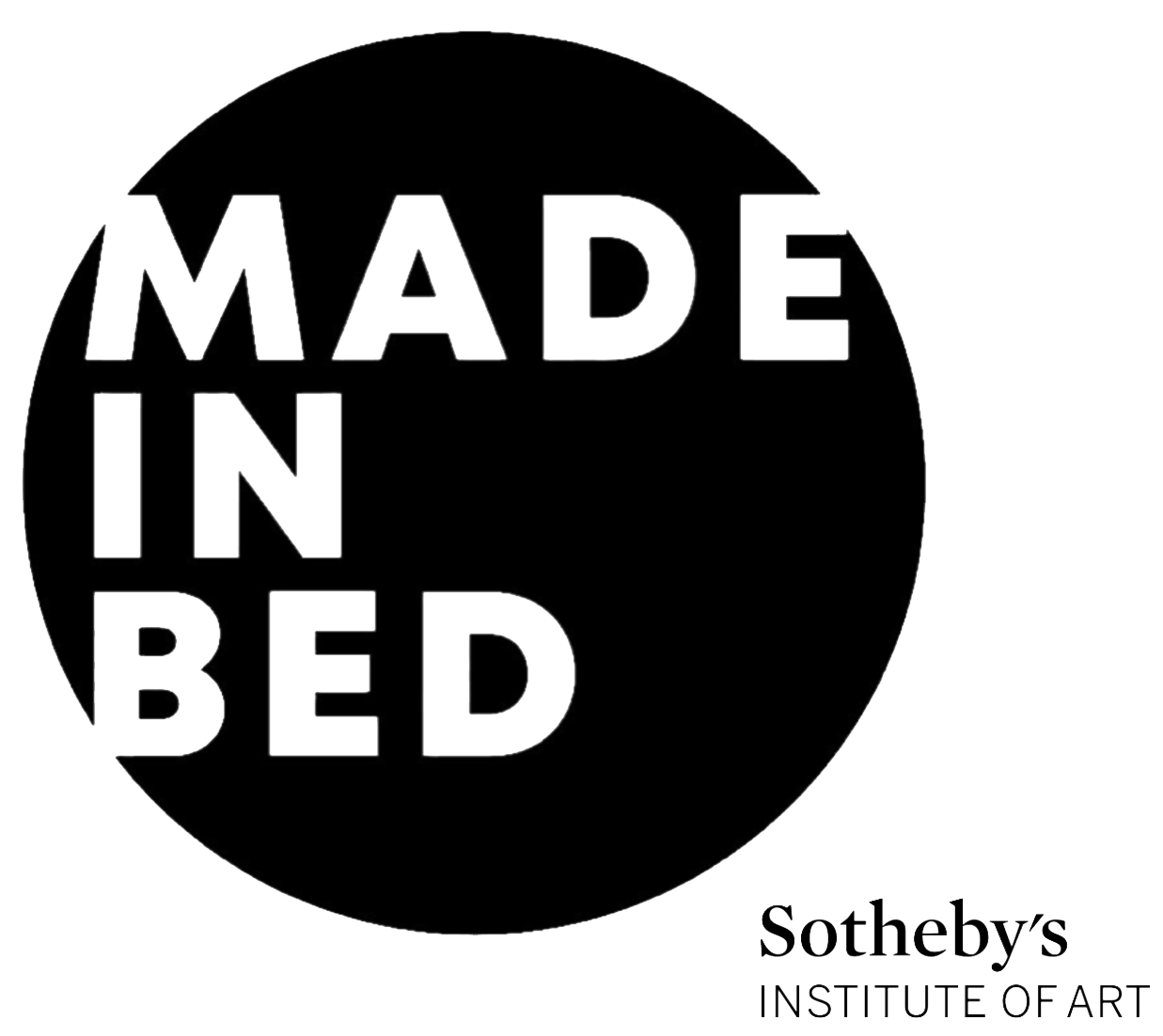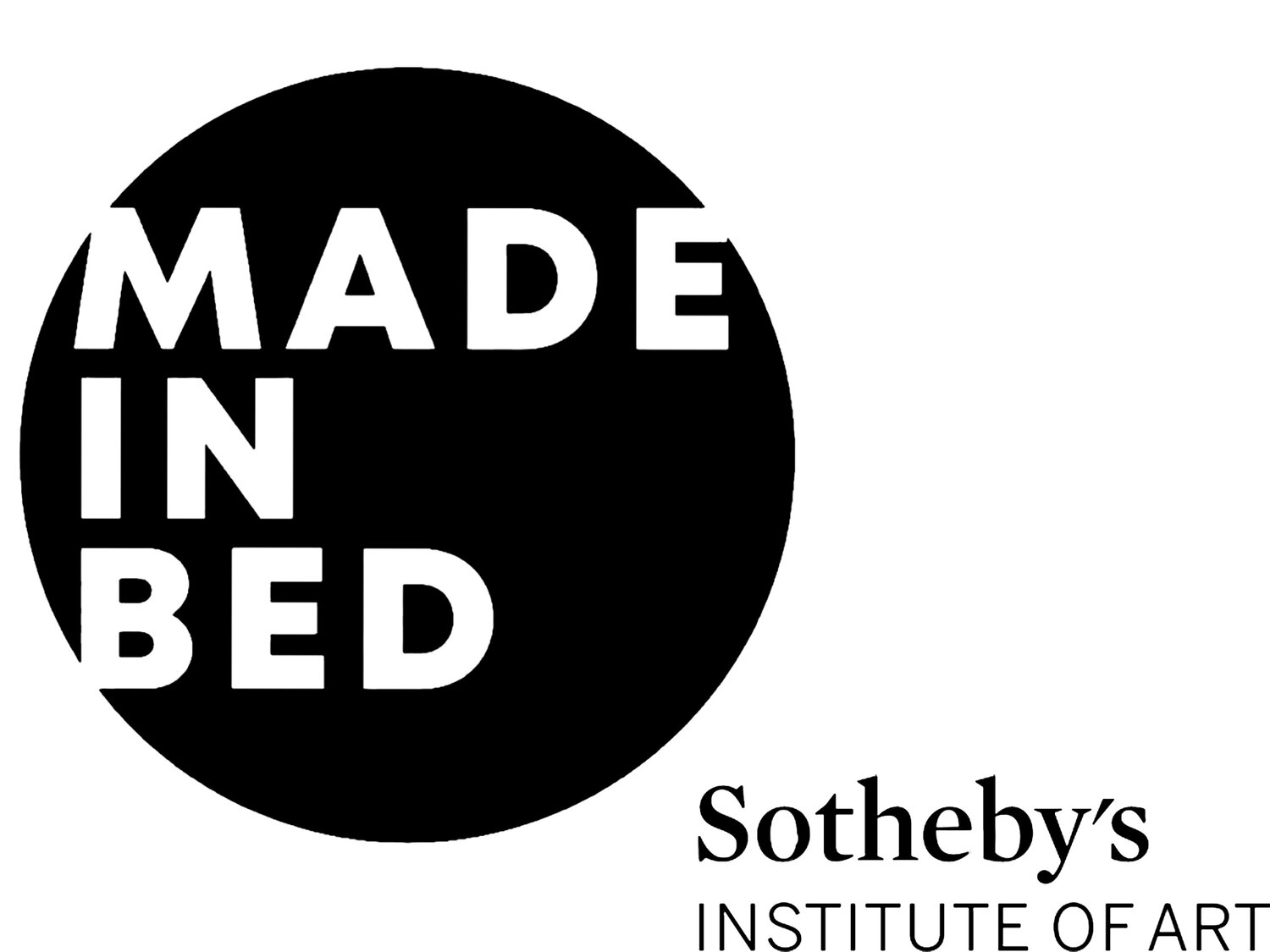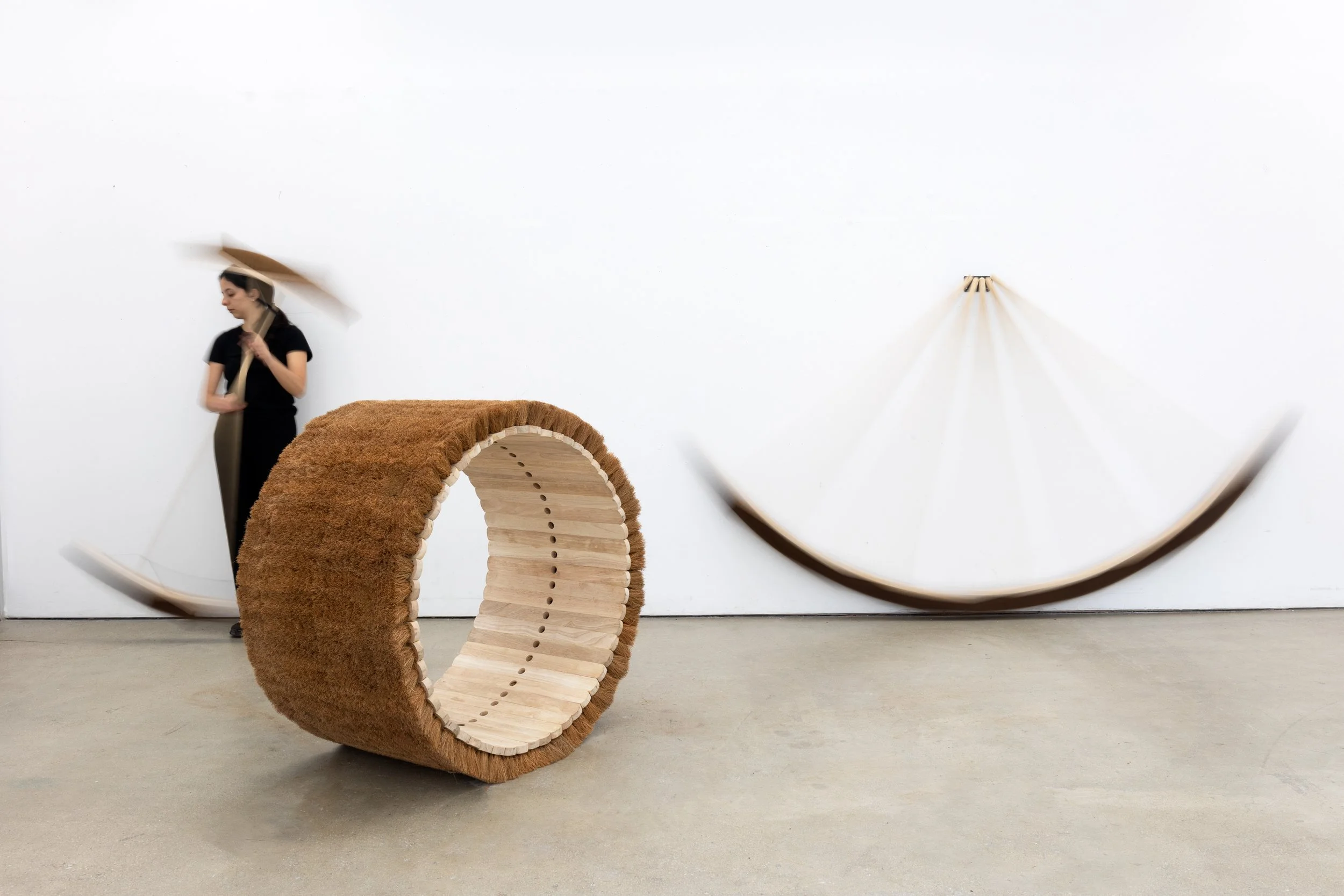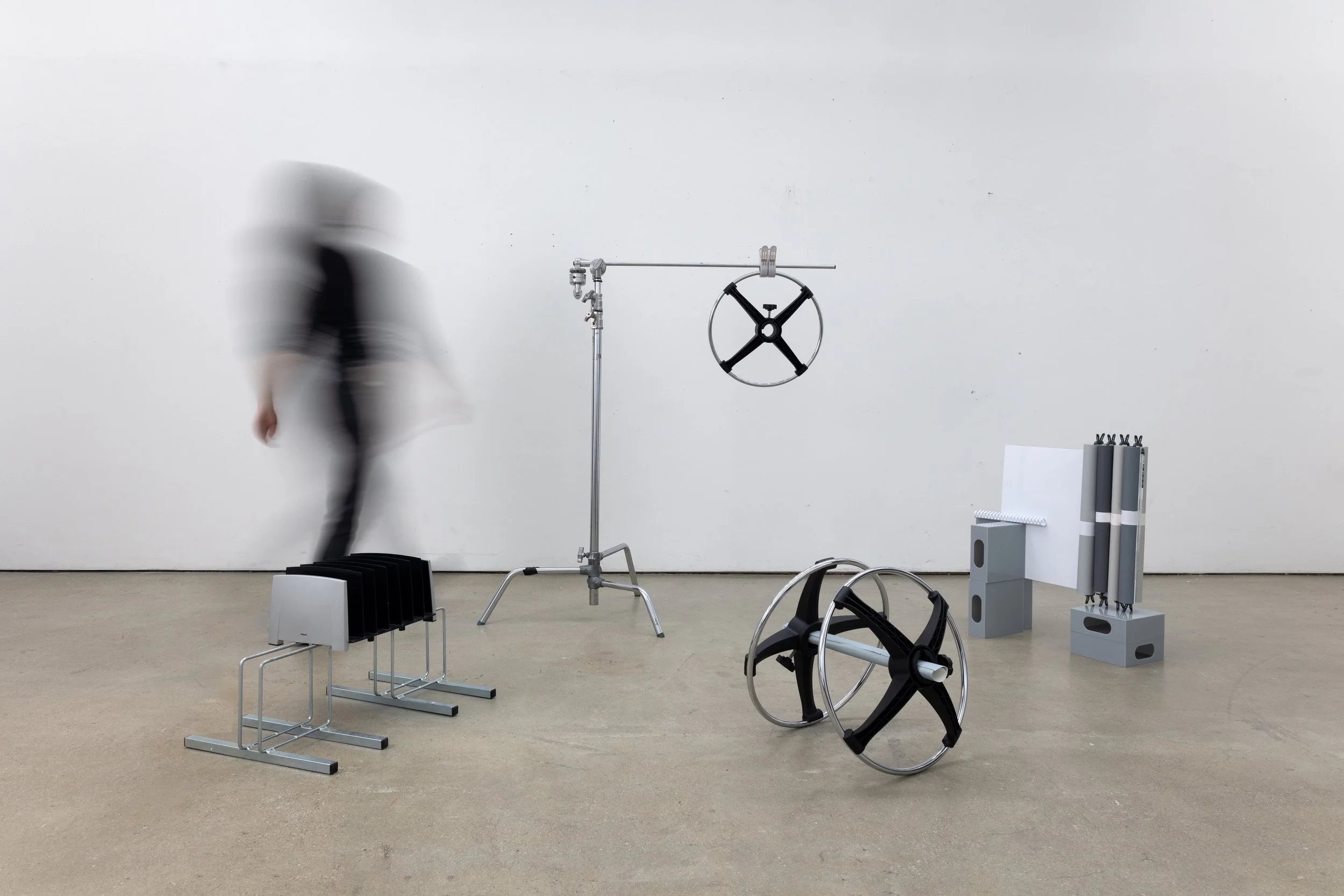Ana María Chamucero
Ana María Chamucero is a Colombian artist whose work moves between sculpture, drawing, and photography. Her creative process often begins with looking at materials, gestures, and the choreography of everyday life.
Ana María Chamucero in her studio at the Royal College of Art. Portrait by Nuria López. Photo Courtesy: the artist.
Born in Bogotá to a family from Pitalito, Huila, her earliest encounters with art were shaped by that town’s strong artistic identity. “Pitalito is known as a city of artists,” she explains. “When you arrive, you’re surrounded by artworks, murals, sculptures, and Pitalito's Road Art Museum, all featuring works by local artists. But beyond that, you’re also welcomed by the striking beauty of the Laboyos Valley, a land full of breathtaking nature, vibrant green hues and rich textures. I think my relationship with art started there, collecting leaves, seeds, and playing with them as a child.”
Chamucero recalls that her first works emerged through drawing. “In 2013, I began a series of pencil drawings depicting the landscapes I saw along the road between Bogotá and Pitalito,” she says. “I imagined them as panoramic drawings, stretched out horizontally, like when you look out from a car window and see the landscape passing by.” Around the same time, she began experimenting with photography, capturing compositions made with organic materials she found in nature such as bamboo and tree bark, leaves, and guava skins. “Those were the first pieces I made I thought of as art,” she adds. At high school, her art teachers encouraged her to pursue what had already become a deep part of her identity. “Every year, some of the senior students would have a small exhibition. I always wanted to be part of that,” she recalls. “When I finally had the chance to participate, I thought, This is what I want to keep doing in life.”
Ana María Chamucero, El trazo del Cálamo. Solo Show. MAAP Museum of Archaeology and Art. Pitalito (2023). Photo Courtesy: the artist.
That conviction led her to study Fine Arts at Universidad de los Andes in Bogotá, where she began to explore the transition from drawing to sculpture. “Throughout my undergraduate studies, I kept drawing. It has always been my language,” she explains. “But when I moved into sculpture, I thought of it as drawing in space”. She describes an early translation from line to volume in works she made in 2017, where drawings of clothes hangers became arrangements of gridded cubes. “At first, I wasn’t really thinking in three dimensions, I was just drawing in a different way.”
A formative thread in her work is movement. Informed by years of ballet training, the studio became another place for the body to rehearse. “When I stopped dancing, my body missed that physicality. Sculpture allows me to be in motion again. Lately, I see sculpture as a choreographic practice.” She often describes her works as “choreographic-assemblages,” where objects are arranged not just to occupy space but to propose sequences of action, merging the repetitive and meditative aspects of movement with the logic of construction. “When I danced, objects on stage were props,” she says. “In my sculptures they are no longer props. They become independent bodies.”
Ana María Chamucero, Walker, 2017. Photo Courtesy: the artist. Image by Jorge Pico.
This framework culminated recently in Sweepers, a series of assemblages developed during her Master’s in Sculpture at the Royal College of Art in London. The group includes three pieces: Pendulum, five street brooms suspended to swing rhythmically, Wheel, a circular construction made from broom heads, and Paddle (Double-Sided Broom), a broomstick fitted with brushes at both ends. Each piece invites interaction. A push sets the pendulum in motion, and the wheel can be rolled, yet both resist utility. “They all still work,” she smiles, “just not in the same way”. The choreography aspect of the making is literal. “I had to train the brooms,” she says. “I rehearsed movements with them and tested structures so they could move without losing their identity as brooms”. Here the object ceases to be a prop and becomes a performer, what she calls “a dancer in itself.” Titles are deliberately plain: “Pendulum, Wheel, Paddle (Double-Sided Broom), it is what it is,” she says. “The poetry is found in the movement, or the remains of it.”
Ana María Chamucero, Sweepers, 2025. Photo Courtesy: the artist.
Photography is often an integral part of her process too. “In Bogotá, I began taking pictures of improvised street assemblages, such as baby strollers repurposed as vending carts and other inventive solutions to everyday needs, that were initially conceived as temporary but often became permanent structures” she says. “When I arrived in London, I began taking similar photos here, but the objects and solutions I found were different. They were actually temporary and often gone the next day.” During her walks around the city, she discovered the distinctive street-cleaning brooms used in the United Kingdom and decided to “Colombianize” them, a verb she uses to describe infusing objects with a mix of ingenuity and absurdity. “It is absurd, but ingenious. In Colombia we solve problems in smart, practical, and unexpected ways. My work often seeks to evoke that.” Her relationship to objects often begins by chance. “I do not go out looking for things,” she explains. “I find them by accident, and if something catches my attention I start exploring its possibilities. I believe objects have their own knowledge. I try to listen to them.”
Ana María Chamucero, Storage Strategies, 2023. Espacio Alterno Gallery, Bogotá. Photo Courtesy: the artist.
Writing and drawing remain close to her process. “I used to keep diaries of drawings,” she says, but the order has shifted. “I no longer start my pieces from drawings or sketches as much as I used to. I experiment with the objects first, then draw and write about their behavior after, as a way to clarify what I have learned from them.” The familiarity with line and repetition typical in drawings still shapes her work. “Even in sculpture I see patterns repeating themselves like loops of thought.” Repetition is closely tied to her personality. “My mind is very anxious. I think about things over and over again. I realized just recently that my sculptures reflect that. The Pendulum, for example, moves back and forth, endlessly, like my thoughts.” While her earlier works in Pitalito explored through organic materials the history of the place, the boundaries of territory and land division, her recent projects focus on the everyday, on finding poetry in improvised and clever solutions. “Collecting and accumulating are central to my process,” she says. “I collect objects and images, but also thoughts.” Living abroad sharpened her sense of cultural identity. “I love Colombia. I did not really want to leave,” she admits. “But once here, I felt the need to hold onto and delve into my Colombian identity and show its positive side. We are resourceful and imaginative.”
Ana María Chamucero, Pendulum, 2024. Photo Courtesy: the artist.
London also introduced her to a different economy of objects. “People discard things quickly here. In Colombia, objects are often repurposed and given new lives for years before they’re ever thrown away.” This shift in material culture has shaped her recent works in progress, which she is building from discarded office materials. These are taking the form of modular structures: adaptable, mobile, and constantly shifting rather than fixed in a single configuration.
Ana María Chamucero, Work in Progress, 2025. Photo Courtesy: the artist.
Her work has been featured in exhibitions such as Artecámara 2021 (the emerging artists’ section of ARTBO, Bogotá’s International Art Fair) ; the virtual event Bienal Online: Mês da Videoarte 2021 as part of the Curitiba Biennial in Brazil; and the YICCA International Contest of Contemporary Art (Zagreb, Croatia, 2019), where she received first place. Most recently, she was nominated for the Premio Arte Joven 2024 (Young Art Prize Colombia), having also been shortlisted in 2020.
Looking ahead, Chamucero envisions expanding her sculptural language through performance while continuing to work between Colombia and London. “I would love to delve deeper into performance, exploring the relationship between objects, movement, and the body,” she says. “And to keep presenting my work in both countries—and wherever else it may find a home.”
Ana María Chamucero, Wheel, 2025. Photo Courtesy: the artist.
Find out more about Ana’s work on Instagram
Ana María Chamucero, Loofah Succession, 2025. Photo Courtesy: the artist.
Mariana Duque Mordecai
Social Media Manager, MADE IN BED










